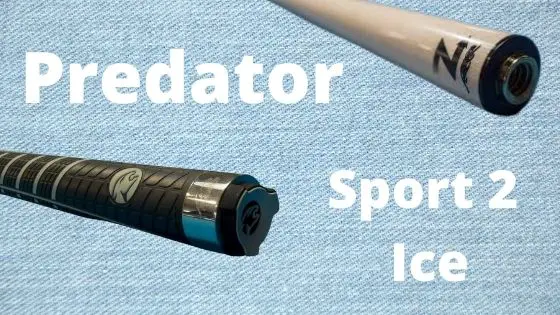Introduction.
Whether you are a keen amateur pool player or just starting out on this great billiards journey, it won’t be long before you hear the word deflection. The speaker could be talking about the cue ball movement, the deflection of the shaft or the latest low deflection high technology cue shaft to be brought to market.
Whatever the reason you will find more information in the article below to help you to understand selection, discuss its properties or make a cue purchase.
There are low deflection pool cues and you can also buy a low deflection shaft to replace your standard shaft on your favorite playing cue.
What is Deflection in Pool?
When side spin is applied to the left side of the cue ball the ball deflects to the right and vice versa. This deflection is what makes the game so difficult for many players.
Deflection is sometimes referred to as squirt. So what is the difference between a low deflection shaft and a low squirt shaft? Nothing, its just another term descibing the same action.
When shooting shots with sidespin the player needs to make an allowance for this deflection. This is done by aiming either thicker, or thinner to such an extent that the cue ball arrives at the object ball in the correct position.
The amount of the allowance can be worked out by trial and error and eventually will become a natural part of your shot selection process It is however possible to play without using side spin but that discussion will have to wait for now.
What does Deflection Mean to a Player?
This deflection means that when applying side spin the player needs to make an allowance for the deflection when aiming the shot. Deflection will increase with speed and cue elevation.
The ball will eventually move back to the shot line if the distance is sufficient. This causes a swerve motion in cueball travel.
Because the amount of swerve depends on the type of shot, cue power and distance there are a number of calculations to be made when applying sidespin.
The amount of deflection can be reduced with an LD (low deflection) cue shaft. This helps to simplify, but not eliminate the variables inherent in shots with English.
What is a low deflection cue?
A low deflection cue or more specifically, a low deflection cue shaft, is a shaft that has been specially designed to move out of the way of the cue ball causing less deflection. These shafts have less end mass than standard cue shafts.
When a hard object strikes a hardball at a speed of say 10 miles per hour, at the moment of impact the hard object is still moving but the ball has not yet reached an equivalent speed.
This energy has to go somewhere.
As a result of this:
When applying sidespin/English to the cue ball, as the cue tip strikes the ball off-center the shaft Bends to one side pushing the cue ball in the opposite direction.
This push can be reduced if the end mass of the cue shaft is reduced. this has been achieved by quite a few cue manufacturers to some degree of success, although, reducing deflection down to zero that’s not being achieved and would likely not be desirable to all players.
How Do Pool Players Allow For Deflection?
As mentioned above when sidespin is added to a shot the cueball moves slightly in the other direction. Pool players adjust their aim accordingly until the application of spin becomes a subconscious part of their overall game. This process is very tricky and can be messed up on the simplest of shots.
Backhand English (BHS) and front hand English FHE) can reduce the calculations on most shots and will be discussed in another article on this site.
Allowing for parallel English, where the whole cue is moved over to one side of the ball does take longer to incorporate into a players’ game.
Wooden pool cues vary in the amount of deflection even from the same manufacturer.
This is where the low deflection cues come into their own as carbon fiber has made the standardization of cue shafts a lot easier to achieve.
Will Using an LD Shaft Make Me A Better Pool Player?
I was going to say no, because if you can’t play very well now then why would an LD shaft improve your game? Surely you would be wasting both time and money!
Then I thought yes, it could because the shaft will allow a greater margin of error on center ball shots if you generally have a habit of hitting to the left or right of center.
Yes, it could make it easier for you to make adjustments and allowances when playing shots with sidespin.
Yes, having a low deflection shaft could make you feel good and give you an extra boost of confidence that you need.
So, having said all of that, I must also add that it is possible that a low deflection shaft may help with some aspect of your game but in my opinion, changing equipment is unlikely to make you a significantly better player.
Predator Cues.
Starting with the 314 shaft around 20 years ago, Predator got mixed reviews on this shaft. Many players took to the hit straight away. They have since followed up with the 314 versions 2 and 3.
The wooden Predator shafts are made from laminated sections of maple which are glued together radially to form a shaft which is more consistent.
Predator also developed the European tapered Z shaft and the vantage shaft.
The Z shaft has what they call a conical taper which gradually gets wider from the tip to the joint. Similar in fact to most snooker cues
The vantage shaft is a stiffer, thicker. low deflection shaft.
Predator developed the first black carbon fiber shaft the Revo which is available in two tip sizes. The shaft has been very popular with many players.
The Predator Revo shaft is made from black carbon fiber. It now comes in a couple of different tip diameters, and in my opinion the newer shafts are better.
OB Shafts.
Wooden cue shaft maker with the OB1 and OB2.
These have been popular with many players who report a hit closer to the original maple shafts.
Meucci Cues.
Meucci started with the red dot and then the black dot both of which were just really slightly lower deflection than the original Meucci shafts.
They followed up with “The Pro” which is a wooden shaft with lower-end mass and more recently with the carbon pro. I have no reports as to the shaft’s performance at this time.
Cuetec Cues.
Cuetec has developed a carbon fiber shaft that has a white ferrule. This low deflection shaft has turned out to be really popular due to its hit which is less “hollow” sounding than the predator.
This shaft was apparently developed with the help of Shane Van Boening who is sponsored by Cuetec and uses the shaft on the pro circuit.
Kantana Cues.
Produces the K1 and K2 which are wooden shafts with white ferrules are also popular. I haven’t tried these but the many players who have love them.
Mezz Cues.
Has a line of low deflection cues that are very popular including Mezz hybrid pro, the new Mezz ignite carbon fiber shaft.
Mezz WX900 low deflection shaft. Mezz shafts do tend to have a stiffer hit than Predator shafts
One or two professionals do play with these shafts.
Players Cues.
Players cues are low cost but good quality. They have produced a low deflection shaft which is also cheap. It works well and is a viable option for those who cannot shell out $500 for a Revo.
Players low deflection cue shaft called the HXT Skinny 11.75 mm which retails for around $150. I have not used this shaft myself but I hear that this low deflection shaft is worth the money.
Which Low Deflection Shaft is Ideal For Me?
If I knew the answer to that question, I would be a rich man.
Many pool players have their favorite LD shaft and favorite brand.
However, at the end of the day it all comes down to feel and personal preference the same as it does with a standard or regular old style wooden shaft.
Your Choices will Be:
-
-
- Color – natural wood, black carbon fiber
- Shaft Diameter – 11.8mm 12.4mm 12.9mm
- Material – wooden Maple, ash, carbon fibre
- Ferrule Type – short, Long, black, white, or no ferrule
- Length – from around 27″ to 32″ inches
-
Should New Players Start Out with a Low Deflection Cue?
The cost of buying low deflection pool cues or pool cue shafts has become quite expensive. If this advance in playing equipment were cheaper, I would advise all new players to get one.
We have been so used to playing with wooden cue shafts that it could take a while to change over completely for experienced players. But I think that new players would be able to get a great benefit from an LD cue shaft from day one.
The same kind of equipment transformation took place a while back in tennis, many players did resist at the time but later came around. Golf is absolutely loaded with technical innovations to improve the players’ distance or accuracy.



